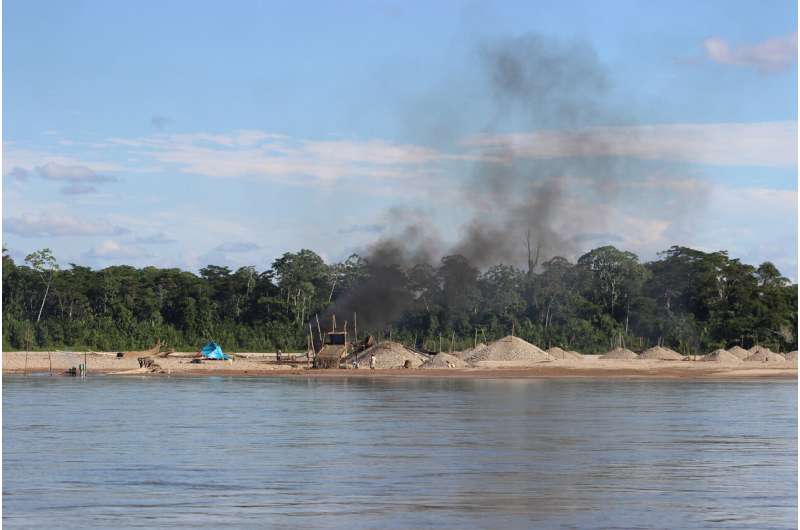Peruvian gold rush turns pristine rainforests into heavily polluted mercury sinks

If you had to guess which part of the world has the highest levels of atmospheric mercury pollution, you probably wouldn't pick a patch of pristine Amazonian rainforest. Yet, that's exactly where they are.
In a new study appearing Jan. 26 in the journal Nature Communications, an international team of researchers show that illegal gold mining in the Peruvian Amazon is causing exceptionally high levels of atmospheric mercury pollution in the nearby Los Amigos Biological Station.
One stand of old-growth pristine forest was found to harbor the highest levels of mercury ever recorded, rivaling industrial areas where mercury is mined. Birds from this area have up to twelve times more mercury in their systems than birds from less polluted areas.
The impact and spread of mercury pollution have primarily been studied in aquatic systems. In this study, a team of researchers led by Jacqueline Gerson, who completed this research as part of her Ph.D. at Duke, and Emily Bernhardt, professor of Biology, provide the first measurements of terrestrial deposits of atmospheric methylmercury, the most toxic form of mercury.
Illegal miners separate gold particles from river sediments using mercury, which binds to gold, forming pellets large enough to be caught in a sieve. Atmospheric mercury is released when these pellets are burned in open fire ovens. The high temperature separates the gold, which melts, from the mercury, which goes up in smoke. This mercury smoke ends up being washed into the soil by rainfall, deposited onto the surface of leaves, or absorbed directly into the leaves' tissues.
To measure this mercury, Gerson and her team collected samples of air, leaf litter, soil and green leaves from the top of trees, which were obtained with the help of a huge slingshot. They focused their collection on four types of environments: forested and deforested, near mining activity or far from mining activity. Two of the forested areas near mining activity are patches with small, scraggly trees, and the third is Los Amigos Biological Station, a pristine old-growth forest that has never been touched.
Deforested areas, that would have received mercury solely through rainfall, had low levels of mercury regardless of their distance to the mining activity. Forested areas, which accumulate mercury both on their leaves and into their leaves, weren't all the same. The four areas with scraggly trees, two near mining activity and two further away, had levels of mercury in keeping with world-wide averages.
"We found that mature Amazonian forests near gold mining are capturing huge volumes of atmospheric mercury, more than any other ecosystem previously studied in the entire world," said Gerson, who is currently a postdoctoral researcher at the University of California, Berkeley.
For all forested areas, Gerson and her team measured a parameter called leaf area index, which represents how dense the canopy is.
They found that mercury levels were directly related to leaf area index: the denser the canopy, the more mercury it holds. The canopy acts like a catch-all for the gases and particulates originating from the nearby burning of gold-mercury pellets.
To estimate how much of the mercury caught in the forest canopy was making its way through the food web, the team measured the mercury accumulated in feathers of three songbird species, in reserve stations near and far from mining activity.
Birds from Los Amigos had on average three times, and up to 12 times more mercury in their feathers than those from a more remote biological station. Such high concentrations of mercury could provoke a decline of up to 30% in these birds' reproductive success.
"These forests are doing an enormous service by capturing a huge fraction of this mercury and preventing it from getting to the global atmospheric pool," Bernhardt said. "It makes it even more important that they not be burned or deforested, because that would release all that mercury back to the atmosphere."
Small-scale artisanal gold mining is an important livelihood for local communities. Akin to the American gold-rush that ravaged California in the 1850s, it is driven by economic necessity, and disproportionally impacts indigenous communities.
"This is not something new or exclusive to this area," Bernhardt said. "A very similar thing, with very similar methods, has already been done throughout many of the wealthy countries of the world where gold was available. The demand is just pushing mining further into new areas."
"There's a reason why people are mining," Gerson said. "It's an important livelihood, so the goal is not to get rid of mining completely, nor is it for people like us coming in from the United States to be the ones imposing solutions or determining what should happen."
"The goal is to highlight that the issues are far vaster than water pollution, and that we need to work with local communities to come up with ways for miners to have a sustainable livelihood and protect indigenous communities from being poisoned through air and water," Gerson said.
More information: Amazon Forests Capture High Levels of Atmospheric Mercury Pollution From Artisanal Gold Mining, Nature Communications (2022). DOI: 10.1038/s41467-022-27997-3
Journal information: Nature Communications
Provided by Duke University





















